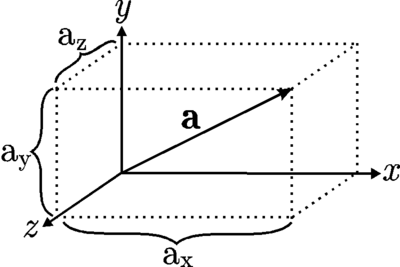一个 向量 是既有大小又有方向的量。向量可以被可视化为箭头。下图展示了我们对向量  的分量
的分量  的理解。
的理解。

两个向量的和  的分量为
的分量为 
两个向量的 点积 是一个数

它的重要性在于它在 旋转 下是不变的。为了证明这一点,我们计算


根据毕达哥拉斯定理, 的大小为
的大小为  如果我们使用不同的坐标系,
如果我们使用不同的坐标系, 的分量将不同:
的分量将不同: 但是如果新的坐标系仅仅是通过旋转和/或平移得到的,
但是如果新的坐标系仅仅是通过旋转和/或平移得到的, 的大小将保持不变
的大小将保持不变

平方的大小 
 和
和  在旋转下是不变的,因此,乘积
在旋转下是不变的,因此,乘积 
由于标量是指在某些变换下(在本例中为坐标轴的旋转和/或平移)保持不变的数字,因此点积也被称为(a)标量积。我们来证明

其中  是
是  和
和  之间的夹角。为此,我们选择一个坐标系
之间的夹角。为此,我们选择一个坐标系  ,其中
,其中  在此坐标系中,
在此坐标系中, ,其中
,其中  由于
由于  是一个标量,并且标量在旋转和平移下是不变的,所以结果
是一个标量,并且标量在旋转和平移下是不变的,所以结果  (不依赖于任何特定框架)在相对于
(不依赖于任何特定框架)在相对于  旋转和平移的所有框架中都成立。
旋转和平移的所有框架中都成立。
现在我们引入单位向量  ,它们的指向由坐标轴定义。它们被称为构成一个正交规范基。正交是因为它们彼此正交
,它们的指向由坐标轴定义。它们被称为构成一个正交规范基。正交是因为它们彼此正交

规范是因为它们是单位向量

它们是“**正交的**”,因为它们是相互垂直的;它们也是“**标准化的**”,因为它们的大小都是 1。 而它们被称作“**基**”是因为每一个向量  都可以被写成这三个向量的 线性组合 —— 也就是说,一个每个基向量出现一次的求和,并乘以
都可以被写成这三个向量的 线性组合 —— 也就是说,一个每个基向量出现一次的求和,并乘以  的对应分量(该分量可以是 0)
的对应分量(该分量可以是 0)

可以很容易地看出 

 这就是我们有以下结论的原因
这就是我们有以下结论的原因

另一个有用的定义(尽管只适用于 3 维空间)是两个向量的 叉积

- 证明叉积是反对称的:

因此,
- 证明

因此 与
与 和
和  垂直。
垂直。
- 证明
 的大小等于
的大小等于  其中
其中  是
是 和
和  之间的夹角。提示:使用一个坐标系,其中
之间的夹角。提示:使用一个坐标系,其中  且
且 
因为  也是平行四边形
也是平行四边形  的面积
的面积  ,我们可以将
,我们可以将  看作一个大小为
看作一个大小为  的向量,它垂直于
的向量,它垂直于  由于叉积产生一个向量,它也被称为向量积。
由于叉积产生一个向量,它也被称为向量积。
(我们省去了证明叉积在坐标轴平移和旋转下是不变的,这是向量所必需的。但是,让我们顺便提一下,如果  和
和  是极向量,那么
是极向量,那么  是一个轴向量。在反射(例如,坐标轴的反转)下,一个普通(或极性)向量是不变的,而一个轴向量改变了它的符号。)
是一个轴向量。在反射(例如,坐标轴的反转)下,一个普通(或极性)向量是不变的,而一个轴向量改变了它的符号。)
这里有一个涉及标量积和向量积的实用关系




















































